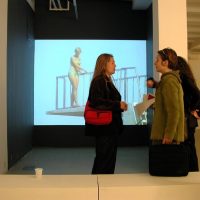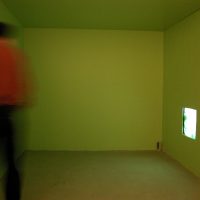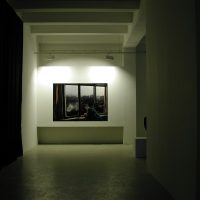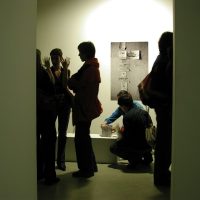The exhibition, whose title was inspired by a writing of Russian artist Yuri Leiderman, is an ongoing dialogue, which allows associations to this author’s ponderings on the lack of a “common space-mode” – the impossibility of a dialogue between the East, stuck in a “topological past,” and the West, “living in a disappearing space” – as much as to the green boxes of Duchamp, who was busy turning himself into a museum piece. Instead of transforming reality into a spectacle, these artists strive for a more nuanced, analytic and/or poetic representation of controversies and events, of experience and identity, cancelling what has become the natural condition, the unconditional and unreflected surrender to the flow of the vision. In his Missing Landscape (2001), a film sometimes slowed to the point of stills, Anri Sala creates tension and an anticipatory mood with the documentary rendering and monotony of children playing football in a bleak landscape. The symbolic space of the makeshift pitch, created by the goals of iron bars and the route of the ball, references the restraints of everyday reality and environment, and the individual’s vulnerability therein, as well as the drama of events which take place behind the scenes.
The young heroine of Johanna Billing’s video, Where She Is At (2001), stalls in a panic before the dive on another end of Europe, on a beach near Oslo. Ingierstrand, the complex of buildings used as the scene, was the first, and also epoch-making, structure of Norwegian functionalist architecture, designed in 1934 by Ole Lind Schistad and Eyvind Moestue, given now to slow decay. Suspense in Billing’s video works is always accompanied by a strange aloofness that mixes with a vague anticipation, and the girl’s hesitation on the diving platform of the modernist resort, once a statement for simplicity and noncontradiction, remains an unresolved source of conflict.
Starting in the late 1980’s as a performance artist and a member of the Tallinn-based T Group, Ene-Liis Semper is now the main character in her own videos. Into New Home (2001) is an endless, dreamlike journey through an unidentifiable land, where the only companion of Semper, herself clad in a white shroud, is a rat. The hallmark of her work is an austere theatricality, which directs the attention to her presence and iconic gestures, performed in a landscape she makes so abstract it is an array of fabulous or mythical archetypes.
It is always in a symbolic situation that the manipulated photos of Aydan Mürtezaoglu explore the paradoxes and conflicts that arise from communication between a private sphere dominated by the family on the one hand, and public life on the other, and which are multiplied by the two-fold identity of being a female artist. The photo-print At Room Temperature (2000-2003) is one of the carefully composed genre pieces or sociological studies whose heroine, herself, expresses a rejection of the situation. Leaning out of the window, blowing cigarette smoke into the polluted air of Istanbul, the female figure balances on the borderline of two worlds, one that is immediate and natural, and one that is artificial and “mediated.”
Wishing to control and analyse her own performance and efficiency, Ioana Nemes created her own, symbolic space on the wall of the dining room in her small and cramped Bucharest flat. Wall Project is a collage – of notes, sketches, photos and graphs –, a work in progress which has been the record of her artistic activity and the attainment of her plans and desires for three years now. The photograph now exhibited is a document of this ongoing dialogue and analysis. The CD that contains her self-interview and the accompanying booklet not only illustrate and comment on the development of the Wall, but also help the viewer understand the formal and mental construction of the project.
Esra Ersen’s works, in which she takes a look at current social issues and situations, are always preceded by a kind of analytical and empirical research. Hamam (2001), presented in a booth, suggests the intimate space of a women’s bath. She invites the viewer on a tour of conflicts in the family and the war of the sexes; the labyrinth is woven by the chat of young women whom the protective mist of the steam bath helps to shed the ties and expectations of quotidian life. Her documentary Brothers and Sisters (2003) shows the life and spaces appropriated and lived by those “invisible” communities of Africans who were cheated by man smugglers, and who were subsequently forced to settle in Tarlabasi, behind Taksim, Istanbul.
Lívia Páldi






